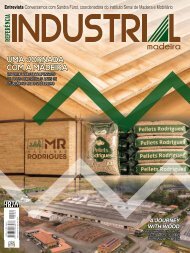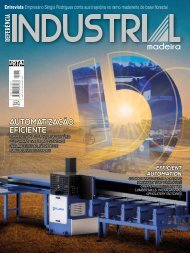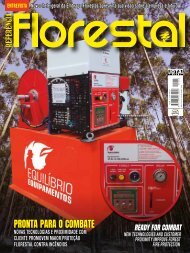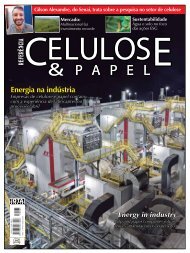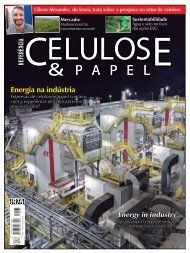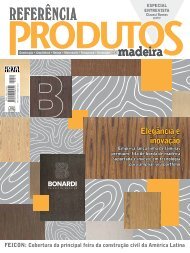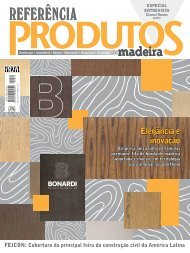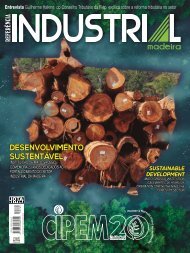Florestal_235Web
Create successful ePaper yourself
Turn your PDF publications into a flip-book with our unique Google optimized e-Paper software.
ENTREVISTA<br />
Cerflor, sendo algumas áreas duplamente certificadas. Esse<br />
sem dúvida nenhuma é o caminho certo a ser percorrido, pois<br />
as certificações não cuidam apenas das condições técnicas<br />
do processo de produção ou do produto final, mas cuidam do<br />
aspecto social e ambiental de nossa atividade. Todas as áreas<br />
são digitalizadas, há o rastreamento permanente e se pode<br />
ter um controle absoluto da qualidade do processamento e<br />
do comportamento social desses nossos fornecedores.<br />
>> No site da ABAF há um conteúdo chamado: Mitos do eucalipto.<br />
Qual o objetivo deste material?<br />
Ainda existem algumas fontes que julgam o eucalipto equivocadamente<br />
como algo que prejudica o meio ambiente. Esse<br />
material é formado com as informações científicas e asseguradas<br />
por procedimentos e estudos de órgãos independentes,<br />
como os membros da academia e EMBRAPA (Empresa Brasileira<br />
de Pesquisa Agropecuária) que mostram que na verdade,<br />
se o processo de plantio e manejo forem feitos corretamente<br />
o eucalipto tem toda a condição de preservar o solo, os recursos<br />
hídricos e até mesmo proteger fauna e flora no processo.<br />
Os nossos plantios são todos feitos em mosaico, dividindo<br />
áreas com a mata nativa, com as nossas áreas de reserva de<br />
mata nativa e os plantios permitem os corredores que facilitam<br />
a sobrevivência da fauna e sem dúvida da flora do nosso<br />
Estado.<br />
>> Quais o principais produtos florestais produzidos na<br />
Bahia?<br />
O carro-chefe é a celulose e papel, mas nós temos o setor de<br />
mineração que tem crescido muito e, assim como o setor de<br />
grãos, utiliza o calor gerado pelo eucalipto para seu processamento.<br />
O setor de pellets para exportação que é uma oportunidade<br />
grande de crescimento, também tem ganho espaço.<br />
Para construção civil a demanda é crescente para projetos<br />
em todos os níveis sociais. Há também agora novos produtos,<br />
como no setor têxtil, por exemplo, hoje é uma grande oportunidade<br />
de investimento com a celulose solúvel, que gera<br />
viscose, que representa, em média 6% dos tecidos comuns. O<br />
ramo de embalagens também tem crescido muito. O setor de<br />
nano celulose, que visa permitir novos produtos que evitam<br />
a utilização de produto de origem fóssil, que evita a emissão<br />
de carbono. O setor florestal consegue plantar no Brasil 1<br />
milhão de árvores por dia. Na Bahia são quase 80 mil árvores<br />
plantadas por dia. O plantio brasileiro absorve 4 bilhões de<br />
toneladas de carbono, que equivalem as emissões brasileiras<br />
totais em 2 anos. Quando a árvore é colhida e processada,<br />
esse carbono continua estocado nos produtos, seja qual for, e<br />
essa é uma vantagem ambiental muito forte que precisa ser<br />
valorizada.<br />
>> Qual a situação do plantio de madeira plantada na Bahia<br />
em relação as preocupação com o meio ambiente?<br />
As florestas plantadas no Brasil atendem 95% da madeira<br />
utilizada pela indústria em geral. Seja uso múltiplo, papel, celulose<br />
e afins. O setor de base florestal, com 9 milhões de ha<br />
management is carried out correctly, it has the condition<br />
of preserving the soil, water resources, and even protecting<br />
fauna and flora in the process. Our plantations are all<br />
made with mosaics, dividing areas with the native forest.<br />
Our native forest reserve areas and the plantations allow<br />
for corridors that facilitate the survival of the fauna and,<br />
undoubtedly, the flora of our State.<br />
What are the main forest products produced in the State?<br />
The flagship is pulp and paper, but we have the Mining<br />
Sector that has grown a lot in our state and, like the Grain<br />
Sector, uses the heat generated by eucalyptus in their<br />
processing operations. The Pellet Export Sector is a great<br />
opportunity for growth. For Building Construction, the<br />
demand is increasing for projects at all social levels. For<br />
example, there are also new products, as in the Textile Sector,<br />
which is a great investment opportunity using soluble<br />
cellulose to generate viscose, which, on average, makes<br />
up 6% of ordinary fabrics. The packaging business has also<br />
grown a lot. The nanocellulose segment aims to produce<br />
new products that avoid the use of fossil-based products<br />
preventing carbon emissions. The Forestry Sector can plant<br />
one million trees per day in Brazil. In the State of Bahia,<br />
there are almost 80 thousand trees planted per day. Brazilian<br />
plantations absorb 4 billion tons of carbon, equivalent<br />
to total Brazilian emissions over two years. When the tree<br />
is harvested and processed, this carbon remains stored in<br />
the products, whatever it is, and this is a solid environmental<br />
advantage that needs to be valued.<br />
What is the situation of planted forest plantations in the<br />
State in relation to concerns about the environment?<br />
The forests planted in Brazil provide 95% of the timber<br />
used by the industry in general. Be it multiple-use, pulp<br />
and paper, and the like. With 9 million hectares of planted<br />
forest and production, the Forest-Based Sector occupies 1%<br />
of Brazilian territory. Eucalyptus has high productivity, and<br />
we are very competitive. We want to produce and process<br />
timber as we produce potatoes, soybeans, and other<br />
grains. Suzano has 40-year-old plantations, and Veracel<br />
has 30-year-old ones, for example. There are planted and<br />
renewed in the same places. This proves that soil and<br />
water resources remain preserved. It is not a predatory<br />
activity that migrates, exploring one area and then moving<br />
on to another. All our plantations are made in areas that<br />
have been abandoned, mainly by livestock, with reforestation<br />
with zero deforestation.<br />
<strong>Florestal</strong>: How does ABAF define the event schedule?<br />
We choose the themes of our industry by demand. Questions<br />
and suggestions always appear because it is a Sector<br />
very much connected with new technologies, and technology<br />
has to be shared. The events open possibilities for<br />
international relationships, studies in new varieties of eucalyptus,<br />
in new processing models, and new management<br />
32 www.referenciaflorestal.com.br







